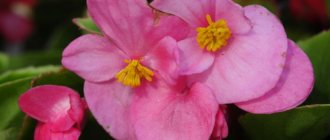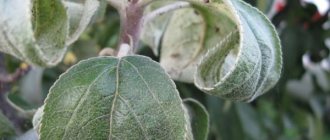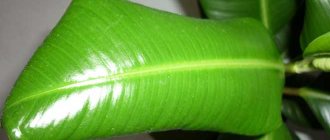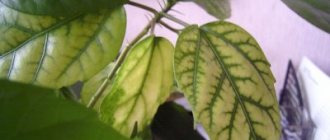The generally recognized “queen of flowers,” the rose, is considered to be a capricious and capricious plant. However, the magnificent beauty responds very gratefully to care and does not require increased attention to her own person. Problems begin only when the plant is not feeling well. If your rose’s castings suddenly begin to curl, do not rush to complain about your pet’s obstinate character. Perhaps the plant is affected by a disease or pests and needs your help.
Powdery mildew
Rose leaves also curl when the plant is infected with powdery mildew. The main symptom of this fungal disease is a dirty white loose coating that thickly covers all above-ground parts of the plant. With severe damage, the curled leaves of roses dry out and fall off, and the “felt” entangled in the shoots prevents new greenery from growing. At the first signs of disease, the rose garden is treated with fungicides, such as:
- Fundazol (10 g/10 l);
- Maxim (10 ml/10 l);
- Fitosporin M (15 g/10 l).
In early spring and autumn, roses are sprayed against powdery mildew with a solution of water (10 l), liquid green soap (300 g), soda ash (50 g), and copper oxychloride (15 g).
Damping off roses
From increased humidity under shelter, roses can develop another ailment - damping off, when the plants literally “cannot breathe.”
This problem can arise if the shelter is made of unsuitable material (for example, thick polyethylene) or the material gets wet during the process and absorbs a lot of moisture, does not dry for a long time or even freezes again in this state (burlap, straw, fallen leaves). Under such a “roof” without ventilation, a microclimate with high humidity very quickly forms, an ideal environment for the development of mold. The stems receive a so-called “infectious burn.”
The same applies to covering rose bushes with snow - with a sharp thaw and then a cold snap, loose snow can compact into an ice crust, under which the plants are also at risk of damping off.
So carefully monitor the condition of the covering material and ventilate your plantings from time to time in the spring.
Severely affected rose shoots should be pruned without regret. If the lesion is not particularly serious, you can clean out the lesion with a knife, and then lubricate the damaged area with tetracycline ointment and seal it with a medical plaster.
The best materials for winter covering of plants 15 covering materials that will protect your plants from freezing, damping off, frost damage and sunburn.
Aphid
This small sucking insect is one of the main enemies of both indoor and garden roses. When aphids are infested, the leaves of the plant become covered with sticky sugary secretions, stick together and curl. By the way, if there are aphids in the garden, then soon their eternal companions will appear - ants, and vice versa, if there is an anthill on the site, then there will be aphids, since for working insects the sweet honeydew secreted by parasites is a favorite delicacy. You can get rid of a small population of aphids using folk remedies:
- daily infusion of celandine (200-300 g of fresh herb per 1 liter of herb);
- citrus infusion (200-300 g of orange or lemon peels per 1 liter of boiling water);
- anti-flea shampoo solution (1 capful of product per 0.5 liters of water);
- kerosene solution (1 tsp per 10 liters of water);
- 7-hour onion infusion (1 medium onion per 1 liter of water).
If aphids on roses have managed to breed, then it is pointless to fight them with folk remedies. Much more effective will be the use of industrial insecticides, such as:
- Agravertine (0.5 ml/0.5 l);
- Actellik (1 ampoule/1 l);
- Vertimek (2.5 ml/5 l);
- Inta-Vir (1 tablet/2 l);
- Karate (0.5 ml/2.5 l);
- Karbofos (15 g/2 l);
- Fitoverm (2 ml/1 l).
Do not forget that ants must be expelled from the garden at the same time as aphids. Against them, it is recommended to install traps with poisoned bait in the area or use special sticky gels. Some experienced gardeners fight ants with improvised means: scald the soil in places where insects accumulate with boiling water, fill anthills with solutions of acetic and citric acid, scatter dry mustard or semolina over the area.
Spider mite
Another worst enemy of the rose is the spider mite. By piercing the leaf blades, the parasite feeds on the sap of the plant. The active activity of spider mites leads to partial destruction of cells and a decrease in the intensity of photosynthesis. With severe damage, the rose leaves curl, become discolored and dry out, and the entire bush is enveloped in the finest silvery web. In addition, ticks are carriers of dangerous viral and fungal infections.
The main reason for the appearance of the parasite is low ambient humidity, so the best preventive measure against it is spraying the rose garden in hot, dry weather. In the fight against spider mites, products prepared according to the following folk recipes have proven themselves well:
- Finely chopped dry stems and leaves of black henbane (1 kg) are poured with water (10 l) and left for 12 hours, then filtered and 20-40 g of liquid soap are added to the composition.
- Dry (200-400 g) or fresh (500 g) dandelion roots are placed in a 10-liter bucket, filled to the top with warm (about 40 °) water and left under the lid for 2-3 hours, and then filtered. The rose garden is treated with the resulting composition three times per season: during the leaf bloom, during the flowering period and 10-14 days after the second spraying.
- Onion peels (200 g) are poured into 10 liters of warm water and put in a dark place for 4-5 days. The prepared rose infusion is sprayed three times with an interval of 5 days.
- Dry tobacco or shag (400 g) is soaked in warm water (10 l) for a day, then boiled for 2 hours, cooled, filtered and diluted with cold water to a volume of 10 l.
- Garlic (500 g) is crushed in any convenient way (in a meat grinder, in a mortar, or finely chopped with a knife). The pulp is filled with water (3 liters) and put in a warm, dark place for 5 days. Before treating plants, the infusion is diluted with clean water (60 ml/10 l) and 50 g of soap shavings are added to the solution.
If the tick is already in full control of the rose garden, experimenting with folk remedies is useless. They will not be able to cope with a large population of the parasite, and time will be hopelessly lost. In this case, you will have to use chemical acaricides or insectoacaricides:
- Apollo (2 ml/1 l);
- Akarin (2 ml/1 l);
- Aktara (1 ml/1 l);
- Kleschevit (2 ml/1 l);
- Oberon (1 ml/3 l).
Preparations intended for the destruction of ticks also include Aktofit, Bicol, Borneo, Demitan, Dursban, Envidor, Nissoran, Neoron, Talstar, etc.
Many of the mentioned products are compatible with bioregulators of growth (Epin, Zircon, Ecosil). In this way, you can simultaneously solve 2 problems: destroy mites and increase the resistance of plants to adverse environmental factors.
Causes of leaf curling
The causes of the painful condition of the main organ of the flower include non-compliance with the conditions for planting the rose. Even before purchasing a seedling, gardeners draw up a plan for placing the crop on the site. They take into account both the plant variety and the time of year the future bush is placed.
Why do hydrangea leaves curl and curl up?
The main causes of leaf curling:
- lack of water;
- high temperature, lack of shade at noon at the place where the rose is planted;
- wrong location;
- the presence of viral diseases;
- pest attack;
- lack of potassium in the soil.
After finding out why the leaves of a rose are curling, gardeners suggest taking active steps to save the flower. Timely control of pests, as well as proper care, will protect the plant from death.
Note! For some types of diseases, only destroying the diseased seedling will help.
Pest control is carried out in several stages
Lack of moisture and high temperature
Rose bushes are watered at least once a week, and even more often on hot summer days. With a lack of moisture, the plant begins to shed buds and leaves. The fact that the leaves are wrapped in a tube is considered a signal of infrequent watering. Too frequent consumption of water also has a bad effect on the appearance of the flower. You should follow the recommendations of experienced gardeners and not create conditions for crop discomfort.
Direct sunlight burns the garden beauty, the flowers become small, the leaves curl and turn yellow. To solve the problem, shade the landing site for the period from noon to evening.
Lighting
Rose is considered a light-loving crop. It is necessary to take care of good lighting for its development and lush flowering. This plant should not be planted near large trees. They block the light, and also make the soil around them depleted and take away nutrients.
Note! It is this kind of land that is actively inhabited by pests.
Viral diseases
When viral diseases occur, the flower loses its buds, and the greenery loses its elasticity and color. The final stage is curling the leaves. It is best to dig up the plant by the roots and destroy it, otherwise the virus will infect neighboring flowers.
Important! The virus that causes the queen of the garden to wilt causes the leaves to curl and shrink in size. The stems die. You need to get rid of the plant.
Rose viral disease
Pests
Gardeners know why rose leaves curl. During the development of young rose seedlings, pests often attack them. The reasons for their appearance are improper soil cultivation and other types of agricultural work. Parasites are located on buds, leaves, petals and cause considerable damage to roses. The most common types are:
| rose aphid | Leaf rollers | Spider mite | rose sawfly | Rose leafhopper |
| Settles in buds, leaves, buds. | The caterpillar larvae feed on fresh, just opened buds, then leaves. | Lives on the underside of a leaf or shoot. | Visible on leaves. | They eat up parts of the plant. |
| It feeds on the juice of shoots and weakens them. The stems become crooked, the leaves may curl, and mold soon appears. | When feeding, the larvae roll up the plant plates, they dry out and die. | Infection is indicated by the presence of cobwebs and deformed leaves. | Parts of the plant change shape, dry out, or an openwork mesh of them remains. | The leaves dry out and fall off. |
Lack of potash fertilizers
A deficiency of potassium fertilizers makes the root system weak, and the plant does not accumulate sufficient moisture. All this interferes with the nutrition of the flower; the appearance of the shoots and leaves signals a problem.
Note! Over time, the leaves turn purple, curl inward and die.
How does potassium deficiency manifest?
Feeding rules
The need for nutrients directly depends on the variety of the rose being grown. One thing is certain: plants should not suffer from mineral deficiency, otherwise the leaves will change color and curl. Pay attention to the regular application of phosphorus-potassium fertilizers, since these elements are responsible for the resistance of roses to diseases and pests. In addition to complex mineral fertilizers, it is recommended to use chicken droppings, wood ash and slurry to feed roses.
Garden roses have leaves that curl inwards - is this normal or not?
A healthy plant has leaves of a juicy bright green hue, shiny, smooth, even, without spots or damage. What to do if the leaves of a rose begin to curl? First of all, you need to understand the reason for the deformation of parts of the flower.
When a rose's leaves curl and begin to dry out, this should alert you
Important! Twisted plates of the plant indicate improper care and maintenance of the garden beauty.











